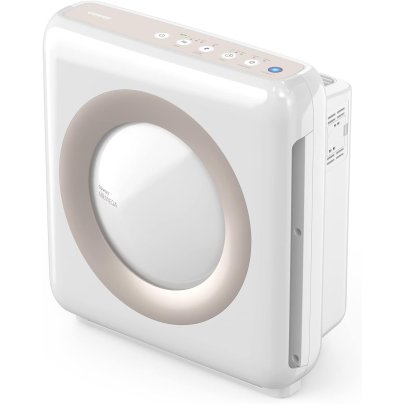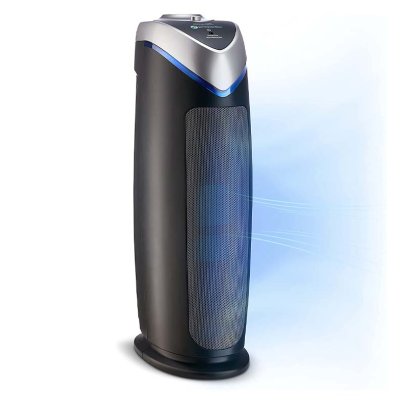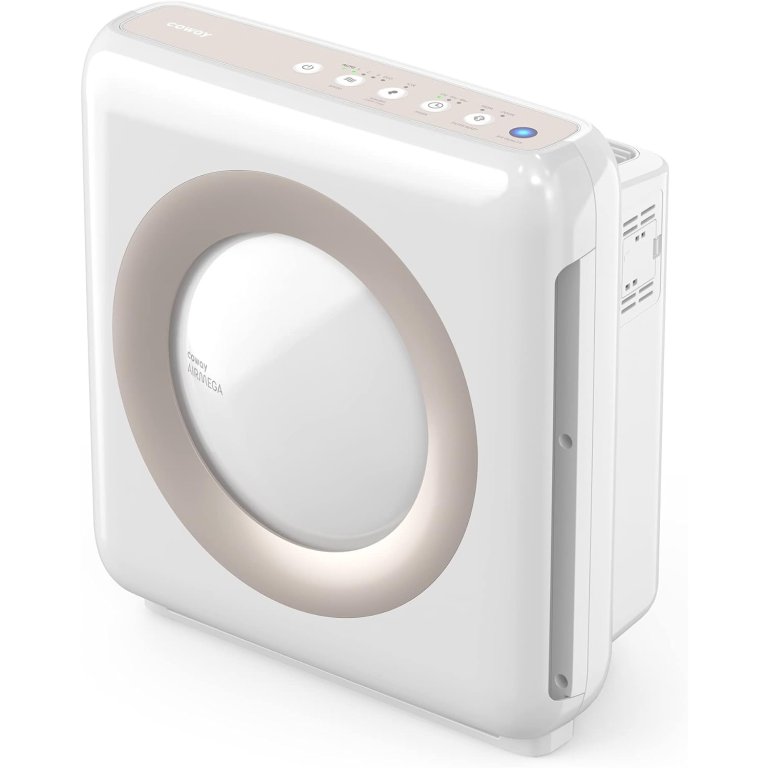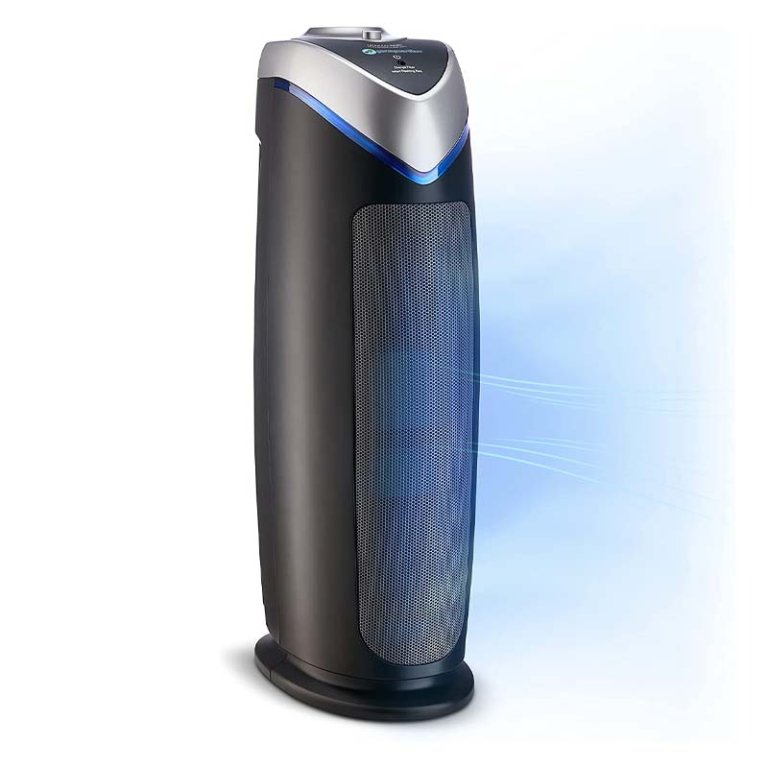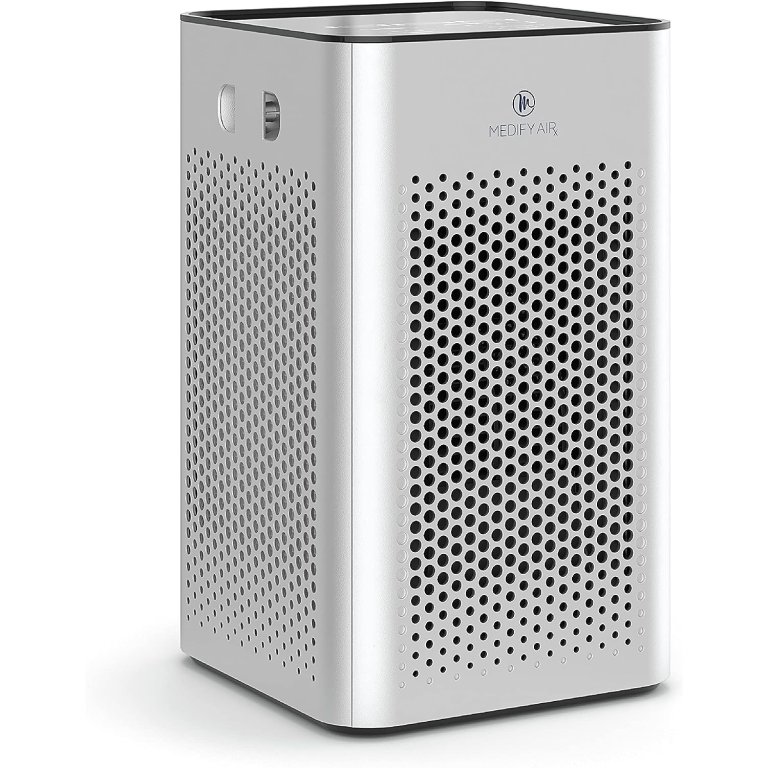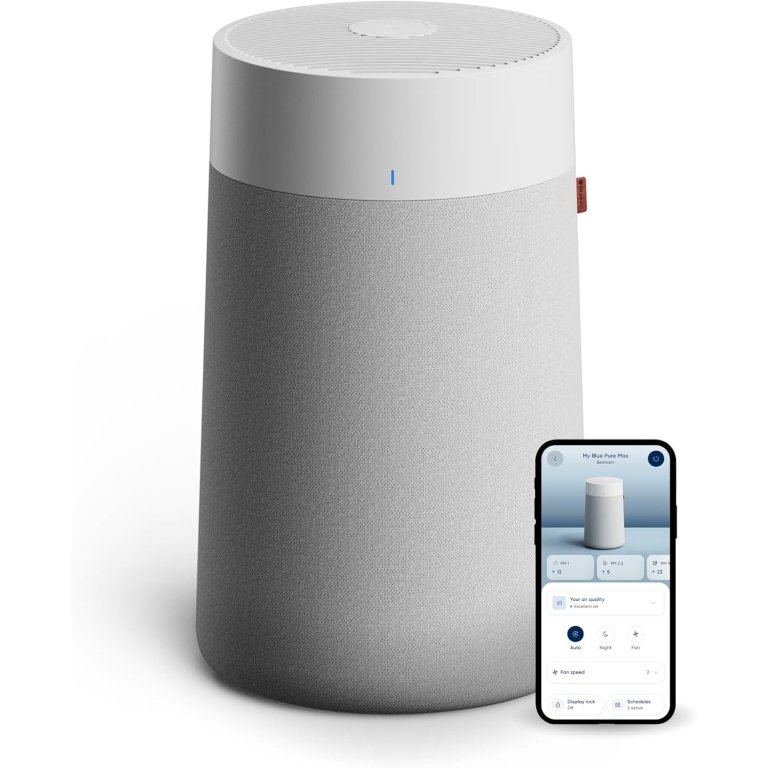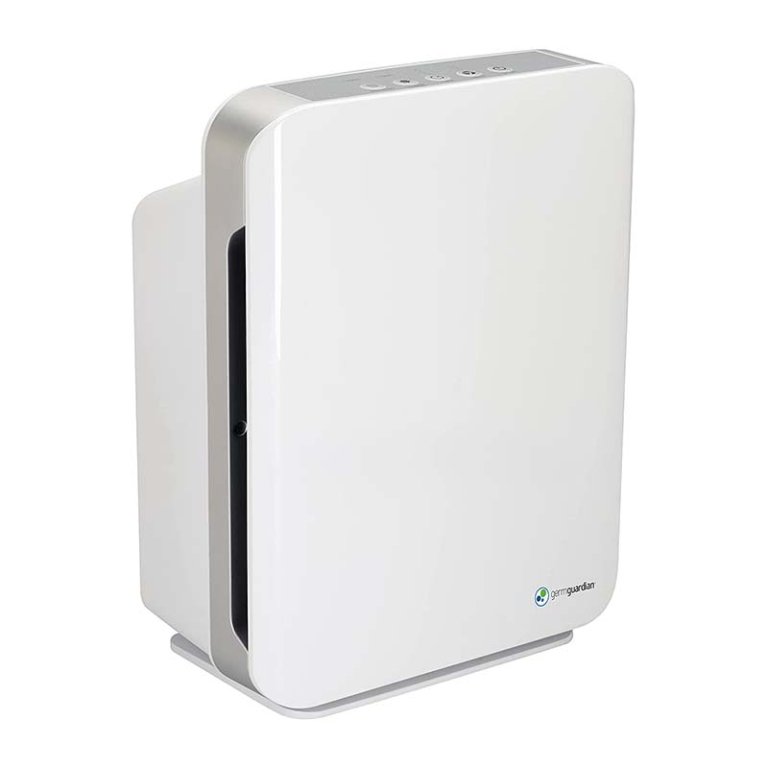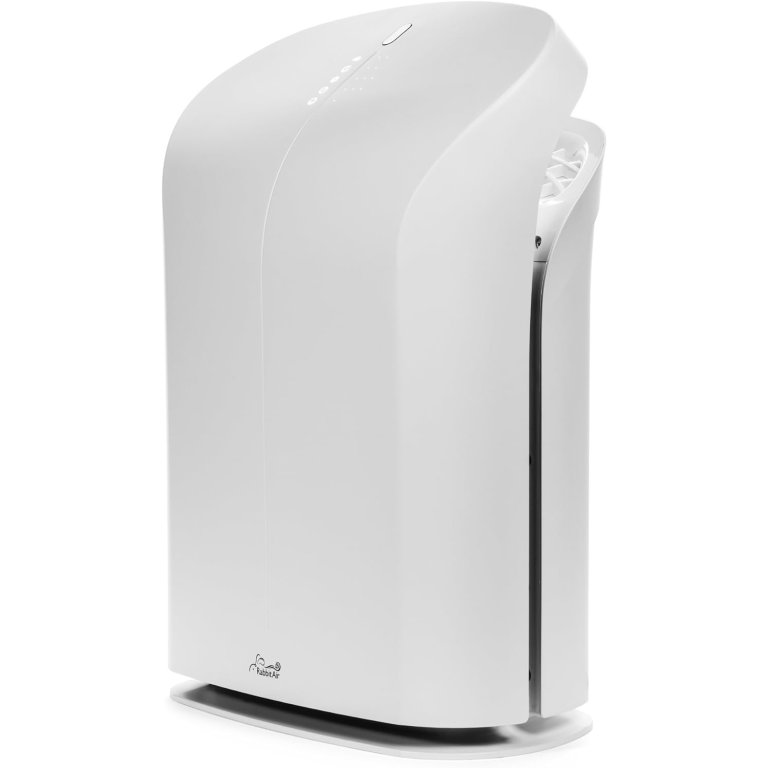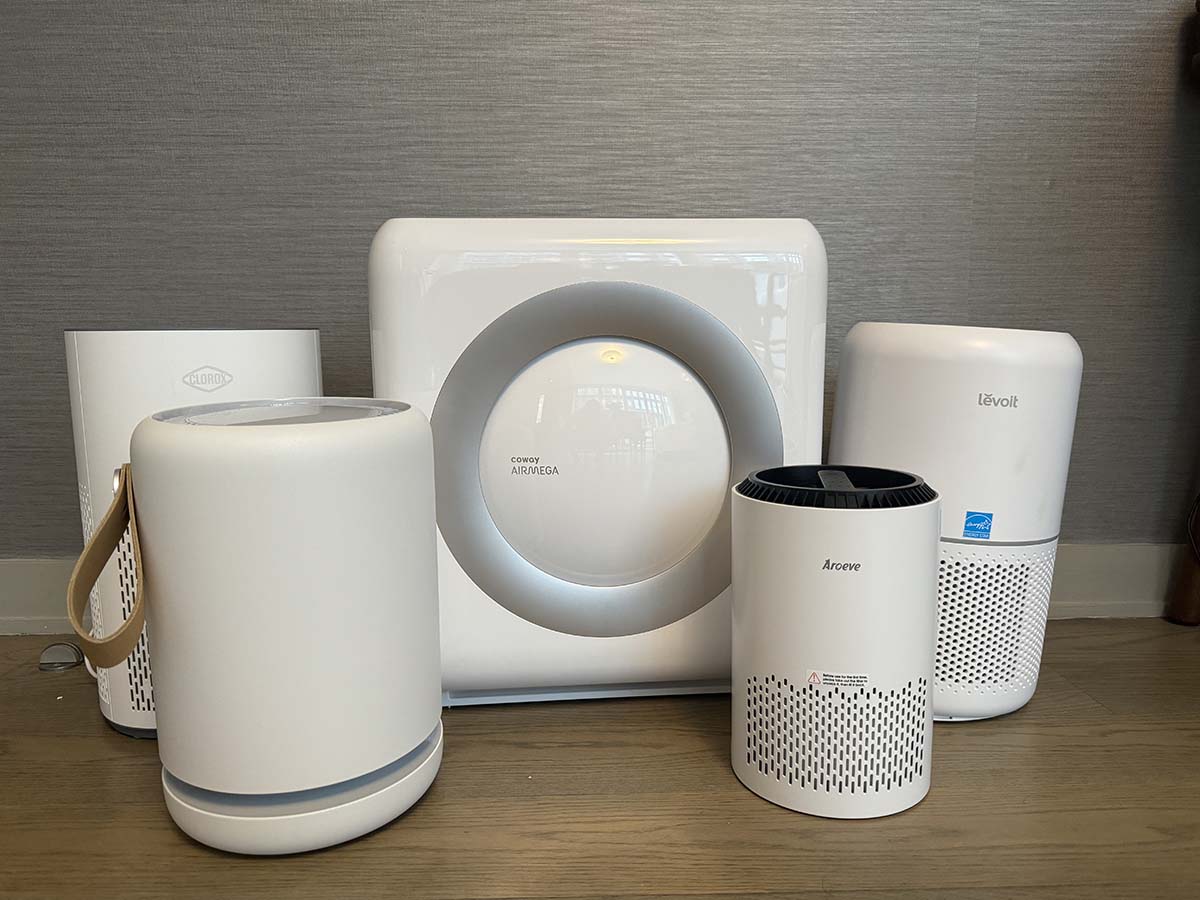
We may earn revenue from the products available on this page and participate in affiliate programs. Learn More ›
Air purifiers for mold help keep your home’s air cleaner and healthier by capturing mold spores before they spread. Mold isn’t only unsightly—it can create musty odors and aggravate allergies or respiratory issues. A reliable air purifier is an everyday essential for maintaining good indoor air quality, as the right model can reduce mold spores along with dust, pet dander, smoke, pollen, and other airborne pollutants.
After researching dozens of popular air purifiers for home and testing several top models, we chose the Coway Airmega AP-1512HH Mighty Air Purifier as the best overall pick for its large coverage area, combination of True HEPA and activated carbon filters (plus an optional ionizer), and relatively quiet performance. While it’s still important to address mold growth at its source, one of the options on our list of the best air purifiers for mold can help keep spores from recirculating to ensure a cleaner and more comfortable home.
- BEST OVERALL: Coway Airmega AP-1512HH Mighty Air Purifier
↓ Jump to Review - BEST BANG FOR THE BUCK: Clorox Medium-Room Turbo+ True HEPA Air Purifier
↓ Jump to Review - BEST FOR SMALL ROOMS: GermGuardian AC4825E 4-in-1 Air Purifier
↓ Jump to Review - BEST FOR BEDROOMS: Medify MA-25 Air Purifier With HEPA H13 Filter
↓ Jump to Review - BEST FOR LARGE ROOMS: Blueair Blue Pure 311i Max Air Purifier
↓ Jump to Review - BEST WHOLE-HOUSE: Coway Airmega 450 Air Purifier
↓ Jump to Review - BEST ODOR CONTROL: GermGuardian AC5900WCA True HEPA Filter Air Purifier
↓ Jump to Review - BEST QUIET: Rabbit Air BioGS 2.0 Air Purifier
↓ Jump to Review - BEST MEDICAL-GRADE: Windmill Air Purifier
↓ Jump to Review
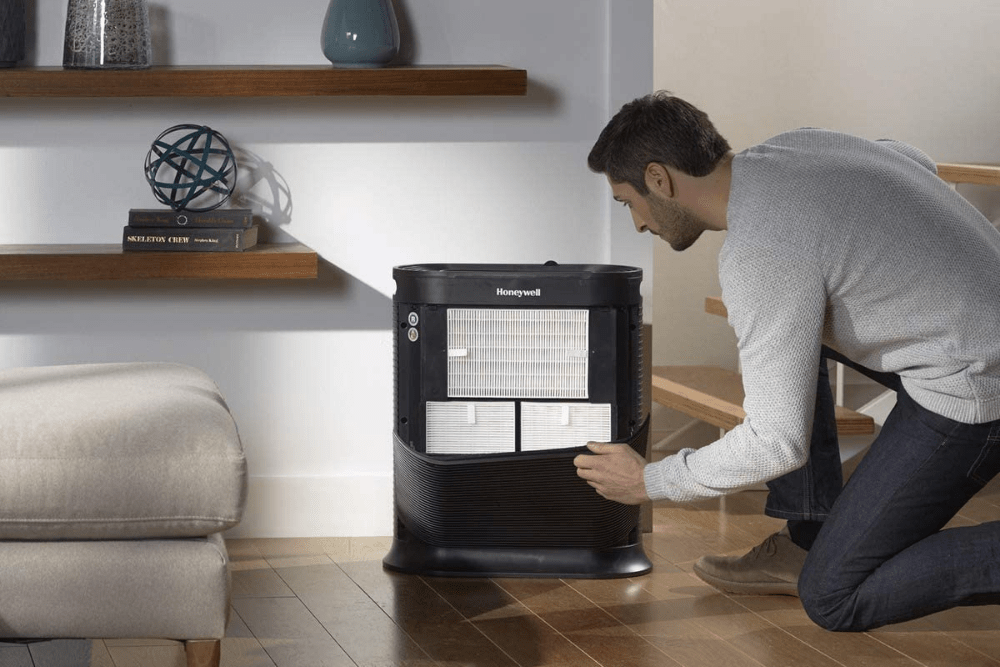
Air Purifiers for Mold Comparison
| Product | Filtration | Maximum Room Size | Noise Level |
|---|---|---|---|
| Coway Airmega AP-1512HH Mighty Air Purifier | Prefilter, activated carbon filter, True HEPA filter | Up to 1,748 square feet | 25 to 53 decibels |
| Clorox Medium-Room Turbo+ True HEPA Air Purifier | Prefilter, activated carbon filter, True HEPA filter | Up to 1,000 square feet | 24 to 50 decibels |
| GermGuardian AC4825E 4-in-1 Air Purifier | Prefilter, activated carbon filter, H13 HEPA filter, optional UV-C sanitizing light | Up to 743 square feet | 40 to 55 decibels |
| Medify MA-25 Air Purifier With HEPA H13 Filter | Prefilter, activated carbon filter, H13 HEPA filter | Up to 825 square feet | 19.8 to 49.3 decibels |
| Blueair Blue Pure 311i Max Air Purifier | Prefilter, activated carbon filter, HEPASilent filter | Up to 2,107 square feet | 23 to 50 decibels |
| Coway Airmega 450 Air Purifier | Prefilter, activated carbon filter, Green True HEPA filter | Up to 3,285 square feet | 23.6 to 57.7 decibels |
| GermGuardian AC5900WCA True HEPA Filter Air Purifier | Prefilter, activated carbon filter, True HEPA filter, optional UV-C sanitizing light | Up to 1,763 square feet | 23 to 50 decibels |
| Rabbit Air BioGS 2.0 Air Purifier | Prefilter, activated carbon filter, BioGS HEPA filter, optional ionizer | Up to 1,100 square feet | 22.8 to 48.6 decibels |
| Windmill Air Purifier | Prefilter, activated carbon filter, H13 HEPA filter | Up to 1,950 square feet | 16 to 54 decibels |
Our Top Picks
Quality air purifiers for mold combine effective filtration with reliable performance and simple upkeep. The following models use True HEPA or medical-grade H13 HEPA filters, deliver powerful performance for their intended square footage, and feature straightforward controls for easy everyday use.
Best Overall
Photo: AmazonWhat We Like
- True HEPA filter tackles mold; carbon handles odors
- HEPA filter expected to last 1 year
- Timer and 5 settings, including energy-saving Eco mode
- Built-in air quality monitor and indicator light
What We Don’t Like
- Bulky square design takes up a bit of space
Product Specs
- Filtration: Prefilter, activated carbon filter, True HEPA filter
- Maximum room size: Up to 1,748 square feet
- Noise level: 25 to 53 decibels
The Coway Airmega has long been a favorite of reviewers and consumers for its comprehensive filtration system that includes a prefilter, deodorization filter, True HEPA filter, and optional bipolar ionizer. Together, these layers effectively capture 99.97 percent of airborne particles as small as 0.01 microns, including mold spores, dust mites, pollen, and pet dander, as well as bacteria, viruses, and germs. Its built-in air quality light indicates whether the air is good (blue), moderate (purple), or unhealthy (red), and when it’s set on auto mode, it automatically kicks off and on as needed.
During testing, the Airmega AP-1512HH’s 16.8-by-18.3-by-9.6-inch frame proved a bit bulky, but since it sits under a window in our bedroom, we appreciated how well it adapted to both indoor and outdoor air quality changes, even during cooking from 25 feet away. Whether the wind was kicking up pollen and dust or we let something go too long on the stove, it quickly ramped up to accommodate the issue. Because it’s an air purifier with a washable filter, it’s very easy to rinse accumulated dust and pet hair out of the prefilter, and the HEPA only needs replacing about once a year.
On its highest setting, the Coway Airmega reaches about 53 decibels, but the lowest speed hums quietly at just 25 decibels, making it an ideal black mold air purifier for bedrooms. It can complete up to one air change per hour in spaces up to 1,748 square feet or 4.8 air changes per hour in rooms measuring 361 square feet.
What our tester says: “We’ve had this Coway in our bedroom for several years, and even though I’ve personally tested close to 20 air purifiers, I’m still impressed by this model’s simplicity and reliability.”—Michelle Larson, Product Reviews tester and writer
Get the Coway Airmega AP-1512HH air purifier for mold at Amazon, Walmart, or Coway.
Best Bang for the Buck
Photo: WalmartWhat We Like
- Effective against mold, allergens, particulates, viruses, bacteria, and odors
- Turbo timer for 10-, 20-, or 30-minute quick cleaning
- Energy Star certified for efficient operation
- Filter lasts up to a year
What We Don’t Like
- Slightly noisy on turbo mode
Product Specs
- Filtration: Prefilter, activated carbon filter, True HEPA filter
- Maximum room size: Up to 1,000 square feet
- Noise level: 24 to 50 decibels
The Clorox Turbo+ True HEPA air purifier is an excellent choice for improving air quality in medium-sized spaces without overspending. Its 360-degree filtration system pulls in air from all sides, capturing 99.97 percent of allergens and particulates, as well as 99.9 percent of viruses and bacteria as small as 0.1 microns. The three-in-one filter is designed to last up to a year, and there’s a convenient indicator light that lets you know when it’s time for a replacement.
During testing, we were especially impressed by the efficient performance of this Energy Star-certified unit. In addition to three speed settings and auto mode, it has a Turbo Timer for 10, 20, or 30 minutes of powerful cleaning when air quality is particularly bad. Because Turbo runs at the highest setting, it is a bit loud (50 decibels), but we found the noise tolerable given how quickly it cleared dust created from dumping out a full vacuum canister and smoke caused by burning five sticks of incense simultaneously. Its efficient performance and easy maintenance make it a strong option for tackling mold spores and mold-related odors in your home.
Get the Clorox air purifier for mold at Walmart or Clorox.
Best for Small Rooms
Photo: AmazonWhat We Like
- Effective against mold, bacteria, odors, and other small particles
- Medical-grade H13 HEPA filter and optional UV-C sanitizing light
- Lightweight and portable with space-saving tower design
- Energy Star certified
What We Don’t Like
- A bit louder overall than other options
Product Specs
- Filtration: Prefilter, activated carbon filter, H13 HEPA filter, optional UV-C sanitizing light
- Maximum room size: Up to 743 square feet
- Noise level: 40 to 55 decibels
The GermGuardian AC4825E features a slim footprint that’s lightweight and easy to move thanks to a built-in handle on the back. Designed to filter the air once per hour in spaces up to 743 square feet and 4.8 times per hour in up to 153 square feet, the Energy Star-certified unit is as effective as it is efficient. Its four-stage filtration system includes a prefilter and an activated carbon filter for large particles and odors, a medical-grade H13 HEPA filter for fine particulates like mold spores, and an optional UV-C sanitizing light for neutralizing airborne biological contaminants, such as bacteria and viruses.
The simple control panel on this model features a dial for its three speed settings, a switch to toggle the UV-C light on and off, and a filter-change indicator light that makes maintenance easy. Although it’s about as loud as most other home air purification systems on high, its 40-decibel output on low is slightly higher than the rest. Still, that’s only about as loud as the hum of a refrigerator, so it’s by no means intrusive. And given its reasonable price, those looking for a mold removal air purifier for small spaces won’t be disappointed.
Get the GermGuardian AC4825E air purifier for mold at Amazon or Guardian Technologies.
Best for Bedrooms
Photo: AmazonWhat We Like
- Energy Star certified
- 3-stage filtration, child lock, and 3 speeds
- Small size and quiet operation
- Easy-to-use touchscreen
What We Don’t Like
- Filter needs replacing 4 times a year
Product Specs
- Filtration: Prefilter, activated carbon filter, H13 HEPA filter
- Maximum room size: Up to 825 square feet
- Noise level: 19.8 to 49.3 decibels
The Medify MA-25 is an Energy Star-certified air purifier with a compact footprint ideal for medium-sized bedrooms and offices. The 13.5-inch-high by 8-inch-wide by 8-inch-deep unit fits easily on a side table or shelf without feeling intrusive. Its three-stage filtration system combines a prefilter, a True HEPA filter, and an activated carbon filter to capture everything from mold spores to pet odors. With CADR ratings of 110 CFM for smoke and 123 CFM each for dust and pollen, it provides one air change per hour for rooms up to 825 square feet and 4.8 air changes per hour for a 172-square-foot area.
This pick has three fan speeds, a timer, and a filter-replacement indicator for easy maintenance. For nighttime use, it runs as quietly as 19.8 decibels, and sleep mode dims the control lights to allow for a darker space. This air purifier for mold spores also has a child-lock feature that prevents accidental setting changes, making it a smart choice for kids’ bedrooms or family spaces.
Get the Medify purifier for mold at Amazon, Lowe’s, The Home Depot, Walmart, Best Buy, or Medify Air.
Best For Large Rooms
Photo: AmazonWhat We Like
- Attractive and innovative design
- Lightweight at just 7.8 pounds
- 360-degree air intake
- Wi-Fi connectivity for remote monitoring and operation
What We Don’t Like
- Top doesn’t always stay on tightly
Product Specs
- Filtration: Prefilter, activated carbon filter, HEPASilent filter
- Maximum room size: Up to 2,107 square feet
- Noise level: 23 to 50 decibels
The Blueair 311i large room air purifier is powerful enough for spaces up to 2,107 square feet, making it ideal for open-concept living, kitchen, and dining areas. With one of the most unique designs of the nearly 20 units we’ve tested, the 311i’s filtration system is actually part of the unit’s aesthetics. Available in four colors—moss, limestone, sand, and Stockholm fog—the prefilter covers the entire base of the purifier, which is a substantially sized cylinder.
The unique construction of this Blueair unit puzzled us at first, as we thought the filter was missing. Once we paired the purifier with the Blueair app, however, we realized the hollow base was the filtration system, which is actually quite ingenious. The 360-degree system has three layers: the attractive prefilter (which you can pull off and wash), the main HEPASilent filter, and the activated carbon filter. It has three speeds, an auto setting, and a nighttime mode, and you can control them all via the one-touch top panel or via Wi-Fi. Since the only real weight is in the top fan housing, it’s also incredibly lightweight and easy to move. Just make sure the top section is on tightly before you pick it up, as it will fall off if it’s not clicked into place.
Get the Blueair air purifier for mold at Amazon, Target, Best Buy, or Blueair.
Best Whole-House
Photo: AmazonWhat We Like
- Whole-house coverage of up to 3,285 square feet
- Fresh Starter+ Filter tackles mold, odors, dust, and viruses
- Real-time air monitoring with color-coded air quality display
- Built-in handle and wheels for easy mobility
What We Don’t Like
- Relatively large at 29 inches high and 13 inches in diameter
Product Specs
- Filtration: Prefilter, activated carbon filter, Green True HEPA filter
- Maximum room size: Up to 3,285 square feet
- Noise level: 23.6 to 57.7 decibels
The Coway Airmega 450 is a high-capacity air purifier designed for whole-house coverage up to 3,285 square feet. Its patented HyperVortex filtration system uses aerodynamic winged blades and a specialized intake duct to create powerful, consistent airflow. It has a three-in-one filter that includes a prefilter, activated carbon filter, and Green True HEPA filter designed to capture mold spores and other pollutants, with CADR ratings of 439 for smoke, 445 for dust, and 450 for pollen.
In testing, the Airmega 450 was both effective and user-friendly. Its color-coded air quality display made it easy to track performance, and the hidden handle and smooth-rolling wheels made moving the 25-pound unit effortless. It has convenient auto, eco, sleep, and turbo modes, plus a timer, three speed settings, button mute, control panel lock, and a night-light. As for noise, it was one of the quietest models we tested on low (23.6 decibels) and also one of the loudest on high (57.7 decibels, comparable to other whole-house air purifiers). While its roughly $500 price tag places it above smaller units, we think it’s an excellent value for such a powerful and well-designed machine.
What our tester says: “I’ve tested a couple of whole-house units, and this one is my favorite. Its cylindrical design is modern and feels unobtrusive, even though it’s almost 30 inches tall. It’s also super quiet on low and rarely has to kick up to high since it’s so efficient.”—Michelle Larson, Product Reviews tester and writer
Get the Coway Airmega 450 air purifier for mold at Amazon, Walmart, or Coway.
Best Odor Control
Photo: AmazonWhat We Like
- Captures 99.97 percent of particles as small as 0.1 microns, including mold spores
- UV-C light reduces VOCs, germs, and bacteria
- 3 speed settings and a timer
- Pleasant white-noise-like output on low
What We Don’t Like
- No auto or eco modes
Product Specs
- Filtration: Prefilter, activated carbon filter, True HEPA filter, optional UV-C sanitizing light
- Maximum room size: Up to 1,763 square feet
- Noise level: 23 to 50 decibels
The GermGuardian AC5900WCA air purifier with HEPA filter combines dependable filtration with easy operation. Its three-layer system includes a prefilter, True HEPA filter, and activated carbon filter to capture mold spores, pet dander, dust, and common household odors. Its optional UV-C light adds another layer of protection by helping neutralize airborne germs and viruses.
With the capacity to cycle air once per hour in 1,763 square feet and four times per hour in 365 square feet, this pick is great for kitchens, basement bedrooms, and other areas prone to odors. The simple control panel makes it easy to adjust fan speeds, set a timer, or activate the UV-C lights. While it’s not a particularly feature-heavy model, the AC5900WCA offers reliable filtration performance for households seeking an effective, low-maintenance way to improve air quality and minimize mold or odor issues.
Get the GermGuardian AC5900WCA air purifier for mold at Amazon or Guardian Technologies.
Best Quiet
Photo: The Home DepotWhat We Like
- Ultra-quiet motor with 5 speed settings
- Filter lasts up to 18 months
- Attractive and highly portable modern design
- Energy star certified
What We Don’t Like
- Optional ionizer produces a negligible amount of ozone
Product Specs
- Filtration: Prefilter, activated carbon filter, BioGS HEPA filter, optional ionizer
- Maximum room size: Up to 1,100 square feet
- Noise level: 22.8 to 48.6 decibels
Not everyone appreciates the sudden sound of an air purifier blasting on to handle a surge of airborne pollutants. Those who find that noise at best distracting and at worst overwhelming will appreciate the Rabbit Air BioGS 2.0. With a sound output of 22.8 on low and 48.6 on high, it’s not the quietest model on our list on either setting, but it is the quietest model overall—especially considering its ample coverage of up to 1,100 square feet. Plus, it has an attractive modern design with a touchscreen you can set to light up only when needed and a cleverly hidden handle that makes the relatively lightweight (16.8 pounds) unit incredibly easy to move.
In addition to impressing us with its portability and sound, the Rabbit BioGS 2.0 also held its own in our performance tests. Its four-stage filtration system, which includes a BioGS HEPA filter for combating mold spores, did an excellent job handling smoke, dust, and odors. Because it’s also an air purifier with ionizer, it enhances particle removal by charging airborne contaminants so they clump together for easier capture by the filters or to settle out of the air, improving overall air quality and freshness. However, since ionizers produce a very small amount of ozone that may irritate the lungs, this feature is optional.
What our tester says: “This is the second Rabbit Air purifier I’ve tested, and I’ve absolutely loved both of their designs. Their lights stay off until you touch the panel, which saves energy and keeps their look clean and modern. They’re also so quiet—I can’t ever tell if the one in my daughter’s room is running unless I specifically check.”—Michelle Larson, Product Reviews tester and writer
Get the Rabbit Air air purifier for mold at The Home Depot or Rabbit Air.
Best Medical Grade
Photo: AmazonWhat We Like
- Medical-grade HEPA filter eliminates 99.97 percent of allergens
- Quieter on low than all other models
- Offers app connectivity for remote monitoring and operation
- Attractive modern design
What We Don’t Like
- Replacement filters are on the spendy side
Product Specs
- Filtration: Prefilter, activated carbon filter, H13 HEPA filter
- Maximum room size: Up to 1,950 square feet
- Noise level: 16 to 54 decibels
The Windmill air purifier combines medical-grade filtration with modern design, making it a strong option for households concerned about mold and air quality who also want something as attractive as it is functional. The three-stage filtration system includes a prefilter, activated carbon filter, and H13 HEPA filter that captures 99.97 percent of particles as small as 0.3 microns, such as mold spores, fine dust, and other common indoor pollutants. Designed for large areas, it can refresh air in spaces up to 1,950 square feet in an hour, and the companion app makes it easy to keep tabs on air quality and filter status.
In testing, the Windmill balanced form and function. After testing in our bedroom for 2 weeks, I noticed fewer complaints about allergies from my husband, and I appreciated how it improved the look of our sparsely decorated bedroom. It was also the quietest model we tested on low and eco modes, though its noise on high was typical for this size. Filters are on the pricier side and need replacement about every 6 months, but the performance and sleek aesthetic make it a worthwhile investment for mold-prone spaces.
Get the Windmill air purifier for mold (various colors) at Amazon, The Home Depot, Wayfair, Walmart, or Windmill.
Jump to Our Top Picks

How We Chose the Best Air Purifiers for Mold
Removing mold spores, odors, and airborne pollutants from indoor spaces helps create a cleaner, more comfortable home environment. Whether you’re considering one of the best air purifiers for pets, smoke, allergens, or mold, it should have effective filtration, quiet operation, and an appropriate coverage area.
When it comes to a high-quality air purifier for mold, each of the models above offers reliable protection via multilayered filtration systems with True HEPA filters, activated carbon filters, prefilters, and, in some cases, optional UV-C lights or ionizers. These layers work together to capture mold spores, trap odors, and reduce allergens and pet dander. Many units also operate quietly or include a dedicated sleep mode for undisturbed rest.
To accommodate spaces of all sizes, we chose models with maximum coverage areas between 825 and 3,285 square feet. Many are lightweight enough to move as needed, and most larger models include features like built-in handles or even wheels to increase portability.
What to Consider When Choosing an Air Purifier for Mold
An air purifier for mold should have a HEPA filter to filter spores and pollutants safely and effectively. When choosing a mold air purifier, consider the unit’s effectiveness, coverage area, and energy efficiency. For air filters used in common living spaces, noise level and design are two more features to consider.
Types of Air Purifiers for Mold
Mold can grow on almost any surface that contains organic material and moisture, and its spores are constantly present in both indoor and outdoor air. Using an air purifier helps capture and remove these airborne spores, improving overall indoor air quality. Many purifiers use technologies like True HEPA filters and activated carbon filters, with some adding features like ionizers and UV-C lights. A few modern purifiers also incorporate advanced oxidation technologies like Photocatalytic Oxidation (PCO) and Photoelectrochemical Oxidation (PECO).
HEPA
HEPA filters have a fine mesh that traps very small particles like pollen, dust, pet dander, and mold spores. When comparing air purifiers, be sure to verify that the filter is labeled as either a True HEPA filter or an H13 HEPA filter. Anything that says HEPA-grade, HEPA-type, or HEPA-like may not have met the HEPA standard set by the U.S. Department of Energy, which is to filter 99.97 percent of particles measuring 0.3 micrometers. Since mold spores typically range in size from about 1 micron to 40 microns, True HEPA filters are appropriate for filtering them out. To remain effective, HEPA filters need to be replaced between every 3 months and 1 year, depending on the model.
Activated Carbon
Activated carbon filters are highly porous and designed to absorb odor-causing gases and VOCs (volatile organic compounds). Since activated carbon filters can eliminate odors, they may help with musty smells from mold. As with HEPA filters, many activated carbon filters require regular replacement, so be sure to check the user manual for your model for that schedule.
Ionic (Ionizer)
Ionic air purifiers electrically charge airborne contaminants to help them settle out of the air or stick to collection plates. This helps reduce airborne pollutants, though you still need to clean nearby surfaces that the particles may have settled on. Ionic air purifiers can also produce ozone, which, according to the Environmental Protection Agency (EPA), can irritate the lungs. For this reason, most ionizers produce only trace amounts of ozone and can be turned off and on as needed.
UVGI
Ultraviolet germicidal irradiation (UVGI) uses UV light to kill microbes like viruses and bacteria. While there is debate about whether UV-C home units provide enough exposure time to fully disinfect the air (which generally takes minutes to hours, not seconds), and some strains of mold resist UV light, this extra feature is still a popular addition to many models.
PCO and PECO
PCO uses a UV lamp and a catalyst to break down gaseous pollutants. However, many home PCO devices have limited effectiveness and may emit ozone or other byproducts. Due to these concerns, the EPA advises caution with PCO purifiers.
PECO is a newer, refined version of PCO that uses low-energy UV-A light and advanced catalysts to destroy a wider range of organic pollutants, including mold spores and VOCs, without producing ozone or harmful byproducts. PECO shows promise, especially in medical-grade air purifiers, but independent consumer testing is still limited. Both PCO and PECO primarily address gases and organic molecules and should be used alongside HEPA and carbon filtration to manage particulates effectively.
Coverage Area
Coverage area is one of the most important factors to keep in mind when choosing an air purifier. The unit you choose needs to move enough air to keep up with the size of your space, and for large rooms or open floor plans, that may mean one big unit or several small ones.
Coverage is typically based on a purifier’s Clean Air Delivery Rate (CADR), which is a measurement of how much clean air a purifier can deliver each minute. Many units have individual ratings for pollen, smoke, and dust, while others use a combined rating or don’t provide this information at all. To make the rating system more consumer-friendly, most air purifier manufacturers convert the CADR rating to a recommended room size by calculating the maximum area in which the unit can clean the air 4.8 times.
As a general guideline, a higher CADR equals faster, more efficient filtration. However, many high-CADR units cost more, so it makes sense to evaluate CADRs in relation to room size. The EPA recommends a minimum CADR of 65 for small rooms around 100 square feet, 130 for medium rooms around 200 square feet, and 260 for large rooms above 400 square feet. Top-performing models may reach CADRs of 450 for pollen and smoke or 400 for dust, which are helpful for especially large spaces or more extreme circumstances. The key is to choose an air purifier with a CADR that matches the size of the room where it will be used to ensure mold spores and other pollutants are filtered effectively.
EPA Rating
For the best results, an air purifier should run continuously or for most of the day. Because these units operate for long stretches, it’s smart to choose one that’s Energy Star certified.
Energy Star-certified models meet EPA standards for energy efficiency, offering the same cleaning power while using less electricity. In fact, they can be up to 40 percent more efficient than noncertified models. That means an Energy Star-certified air purifier can help reduce both energy costs and environmental impact without sacrificing performance.
Air Quality Indicator
The Air Quality Index (AQI) is a scale from 0 to 500 used to report air quality. Readings under 50 indicate good air, over 100 indicate poor conditions, and values above 300 signal dangerous air. While the AQI is often associated with outdoor pollution, it can also apply to indoor air. Many air purifiers now include an air quality monitor and indicator, letting you see the current conditions in your home.
Indoor AQI in a room can change throughout the day, as activities like cooking and vacuuming can temporarily worsen air quality. For that reason, it’s helpful to have a model with auto mode that adjusts to the air quality in your home to ensure cleaner air without constant manual adjustment.
Noise Level
All air purifiers make some noise since they use fans to move air. How much noise level matters depends on where you’re using the unit, the general air quality in your space, and your sensitivity to sound. Bedrooms and living spaces benefit from quieter units, while noise may be less of a concern in kitchens or basements.
Though noise level varies by model, higher settings are always louder. One way to handle this is by running the purifier on high when the room is empty and lowering the speed when people are present. The noise level depends on the model and the purifier’s fan setting. Higher fan-speed settings are often louder. Choosing a purifier rated for a larger room can also help since it can run at a lower setting in a smaller space while still providing effective filtration.
Many purifiers list a noise rating in decibels (dB). For context, refrigerators typically run around 40 dB. Night modes usually operate around 20 dB, while louder units can reach close to 60 dB, similar to the sound of an air conditioner.
Smart Technology
Air purifiers can include a range of smart technology integrations. Look for units with built-in air-quality sensors that monitor real-time AQI. Automatic programs can trigger purifiers to turn on or off in response to air quality. Built-in speed settings, timers, and programmable cycles offer flexibility.
Purifiers with Wi-Fi or Bluetooth connectivity can connect to apps to allow users to monitor and control the purifier remotely. Other air purifiers can connect to interactive voice assistants, like Amazon Alexa and Google Home, for hands-free control.
Portability
When considering portability, first consider where to place an air purifier based on where you spend the most time. Compact, lightweight models are easy to move between rooms and can double as travel options. Smaller units typically have lower CADR values, making them better suited for small spaces like offices, bedrooms, or hotel rooms.
Large-room or whole-home purifiers are less portable but often have higher CADR ratings. Models with wheels or handles are easier to move between rooms, while others are heavier and more cumbersome, which makes them better for staying in the same place.
Additional Features and Ongoing Expenses
Many air purifiers include convenient features that make daily use easier. These can include remote controls, caster wheels or carrying handles, multiple speed settings, scheduling options, dimmable displays, and change-filter indicators that alert you when it’s time to clean or replace filters. Units with easy-access designs make maintenance simpler and faster.
Beyond convenience, filtration design affects both performance and cost. Prefilters trap large particles, protecting finer HEPA filters and extending their lifespan. Some purifiers also include an activated carbon stage to capture odors and gaseous pollutants that HEPA or particle filters can’t remove.
The ongoing expense of replacement filters is another key consideration. Many units contain washable prefilters and only require replacement of HEPA filters. If your model has a three-in-one filter, you generally have to throw the whole thing out. Filter replacement can be costly and can be required anywhere from every three months to once every 18 months, so factor these expenses into your decision.
The Advantages of Owning an Air Purifier
Mold exposure in the home can cause short- and long-term health concerns. Although air purifiers won’t eliminate the source of the potentially dangerous fungus, these devices can reduce the number of unhealthy spores in the air. This can help give peace of mind when investigating or remediating contamination issues.
Since mold is almost always present in the air around us, running one of the best air purifiers available today can help capture it to make the air inside your home cleaner and healthier. They’re also relatively affordable and easy to use.
- The best air purifiers for smoke and mold reduce airborne contaminants in the home, like mold spores, pet dander, odors, and more.
- The reduction of airborne contaminants can improve the quality of life for people with asthma, allergies, and other respiratory conditions triggered by poor air quality.
- Air purifiers are easy to operate and can offer around-the-clock filtering.
FAQs
While air purifiers won’t address the cause of a mold issue, these devices can filter mold spores and other pollutants. Most air purifiers are easy to operate and maintain and only need occasional cleaning and filter changes. Here are some questions to consider when using an air purifier in a home.
Yes, air purifiers help with mold if they’re the right kind. Mold spores are always present, but air purifiers with HEPA filters can remove them from the air and improve air quality. However, air purifiers do not treat active mold spores that are already present on surfaces as this situation calls for professional removal.
Yes, air purifiers that have carbon filters can help remove mold smell from the air. However, it’s important that these air purifier filters also work with HEPA or True HEPA filters to remove the spores from the air as well. To be sure you are getting the best possible odor removal, rely on the GermGuardian AC5900WCA True HEPA Filter Air Purifier.
Dehumidifiers remove moisture from the air and do not have a filtering step. Air purifiers have filters or other methods to remove contaminants from the air. For those who are struggling with a lot of mold spores or want to add measures to prevent it, using an air purifier and dehumidifier together may do the trick.
Air purifiers work by using a fan to sucks air in and move it through a purifying filter or system. Most of the best models on the market are made with HEPA filtration, which filters out dander, pet hair, dust, allergens, and mold as small as 0.3 microns with 99.97% percent efficiency. The cleaner air is then pushed back out into the room.
Yes, all True HEPA filters are highly effective at capturing airborne mold spores by filtering particles down to 0.3 microns; however, they do not eliminate mold growing on surfaces. To fully address mold problems, you need to use a mold remover on the mold source itself or seek professional help.
Mold air purifiers can last for many years with proper maintenance. Consider looking for a new air purifier at the 5-year mark, since new features and more energy-efficient models may be worth the upgrade. For effective purifying, the filter should be regularly replaced or cleaned according to the manufacturer’s instructions.
Meet the Tester
Michelle Larson has been a writer and editor for more than 10 years in the fields of health, business, and the home. Given her lifelong interest in wellness, she became a go-to tester for every air purifier the Bob Vila team can get its hands on. She believes daily use and targeted testing are key to recommending quality products built to last.
Additional research provided by Jasmine Harding and Tom Scalisi.
